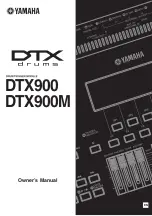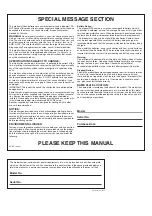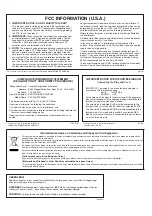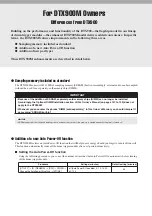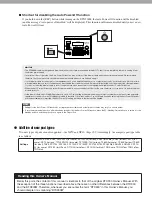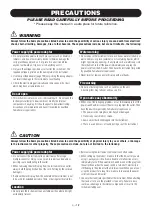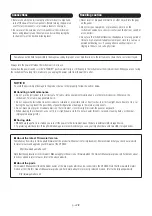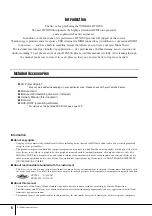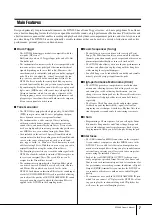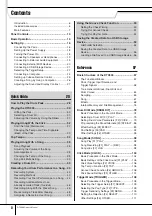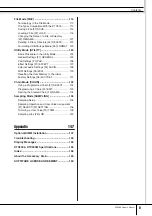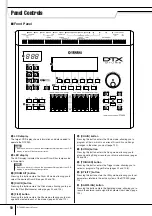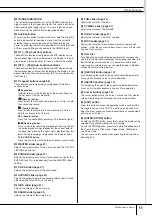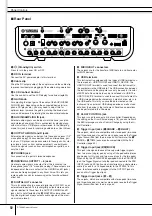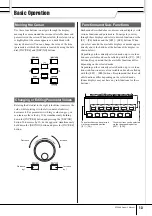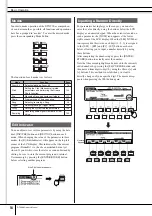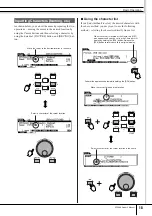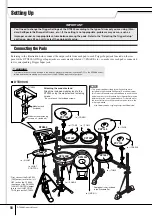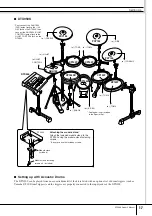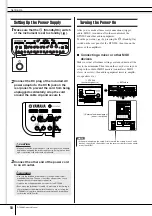
■
Shortcut for disabling the Auto Power-Off function
If you hold down the [REC] button while turning on the DTX900M, the Auto Power-Off function will be disabled
(and the message “Auto power off disabled” will be displayed). This function will remain disabled until you set a new
Auto Power-Off time.
●
Addition of new pad types
Two new types of pads are now supported—the XP70 and XP80. (Page 109.) Accordingly, the complete pad-type table
is as follows.
• The DTX900M remains charged and draws a small amount of power even when turned off. To shut it down completely, therefore, unplug it from
the mains power supply.
• In certain modes of operation, the Auto Power-Off function may not turn off the drum module when the set time has elapsed. We recommend,
therefore, that you always turn off the drum module manually when you are finished using it.
• If your drum module is connected to other equipment such as an amplifier, speakers, or a computer, but you do not intend to use it for some time,
we recommend that you turn off all devices as described in their owner’s manuals. Doing so eliminates the risk of damage to the other equipment.
If you do not want the drum module to turn off automatically when connected to other equipment, disable the Auto Power-Off function.
• When the Auto Power-Off function turns off the drum module, any unsaved data will be lost. Be sure, therefore, to store your work before the drum
module turns off.
• If the drum module’s AutoPowerOff parameter is set to “off”, this setting will be retained when you import system data that was stored externally,
regardless of the Auto Power-Off setting contained in that data. If, however, an Auto Power-Off time has been set using the AutoPowerOff param-
eter and system data is imported, the Auto Power-Off setting contained in that data will be applied.
NOTE
• Settings for the Auto Power-Off function do not represent exact times and actual power-off times may vary to a certain extent.
• To turn the drum module back on after it has been turned off by the Auto Power-Off function, press the
F
(Standby/On) switch once to return it to the
Standby position, and then press it once again to the On position.
Settings
KP125W, KP125, KP65, XP120/100 (for snare), XP120/100 (for tom), XP80 (for snare), XP80 (for tom), XP70 (for
snare), XP70 (for tom) , TP120SD/100 (for snare), TP120SD/100 (for tom), TP65S (for snare), TP65S (for tom), TP65S
(for hihat), TP65, PCY155, PCY135, PCY150S, PCY130SC, PCY130S/130, PCY65S/65, RHH135, RHH130, DT10/
20 (for snare), DT10/20 (for HiTom), DT10/20 (for LoTom), DT10/20 (for Kick), TRG Snare, TRG HiTom, TRG LoTom,
TRG Kick
Reading this Owner’s Manual
Below this point, the content of this manual is identical to that of the original DTX900 Owner’s Manual. With
the exception of the three functions described above, there are no other differences between the DTX900
and the DTX900M. Therefore, whenever you encounter the term “DTX900” in this Owner’s Manual, you
should interpret it as meaning “DTX900M”.
888
NOTICE

